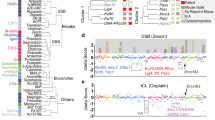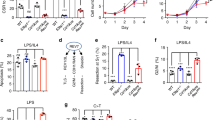Abstract
Activation-induced cytidine deaminase (AID) is a single-stranded (ss) DNA deaminase required for somatic hypermutation (SHM) and class switch recombination of immunoglobulin genes. Class switch recombination involves transcription through switch regions, which generates ssDNA within R loops. However, although transcription through immunoglobulin variable region exons is required for SHM, it does not generate stable ssDNA, which leaves the mechanism of AID targeting unresolved. Here we characterize the mechanism of AID targeting to in-vitro-transcribed substrates harbouring SHM motifs. We show that the targeting activity of AID is due to replication protein A (RPA), a ssDNA-binding protein involved in replication, recombination and repair. The 32-kDa subunit of RPA interacts specifically with AID from activated B cells in a manner that seems to be dependent on post-translational AID modification. Thus, our study implicates RPA as a novel factor involved in immunoglobulin diversification. We propose that B-cell-specific AID–RPA complexes preferentially bind to ssDNA of small transcription bubbles at SHM ‘hotspots’, leading to AID-mediated deamination and RPA-mediated recruitment of DNA repair proteins.
This is a preview of subscription content, access via your institution
Access options
Subscribe to this journal
Receive 51 print issues and online access
$199.00 per year
only $3.90 per issue
Buy this article
- Purchase on Springer Link
- Instant access to full article PDF
Prices may be subject to local taxes which are calculated during checkout






Similar content being viewed by others
References
Jung, D. & Alt, F. W. Unraveling V(D)J recombination: Insights into gene regulation. Cell 116, 299–311 (2004)
Manis, J. P., Tian, M. & Alt, F. W. Mechanism and control of class-switch recombination. Trends Immunol. 23, 31–39 (2002)
Honjo, T., Kinoshita, K. & Muramatsu, M. Molecular mechanism of class switch recombination: linkage with somatic hypermutation. Annu. Rev. Immunol. 20, 165–196 (2002)
Papavasiliou, F. N. & Schatz, D. G. Somatic hypermutation of immunoglobulin genes: merging mechanisms for genetic diversity. Cell 109, S35–S44 (2002)
Li, Z., Woo, C. J., Iglesias-Ussel, M. D., Ronai, D. & Scharff, M. D. The generation of antibody diversity through somatic hypermutation and class switch recombination. Genes Dev. 18, 1–11 (2004)
Chaudhuri, J. & Alt, F. W. Class switch recombination: interplay of transcription, DNA deamination and DNA repair. Nature Rev. Immunol 4, 541–552 (2004)
Muramatsu, M. et al. Class switch recombination and hypermutation require activation-induced cytidine deaminase (AID), a potential RNA editing enzyme. Cell 102, 553–563 (2000)
Revy, P. et al. Activation-induced cytidine deaminase (AID) deficiency causes the autosomal recessive form of the Hyper-IgM syndrome (HIGM2). Cell 102, 565–575 (2000)
Betz, A. G., Neuberger, M. S. & Milstein, C. Discriminating intrinsic and antigen-selected mutational hotspots in immunoglobulin V genes. Immunol. Today 14, 405–411 (1993)
Neuberger, M. S. et al. Monitoring and interpreting the intrinsic features of somatic hypermutation. Immunol. Rev. 162, 107–116 (1998)
Storb, U. & Stavnezer, J. Immunoglobulin genes: generating diversity with AID and UNG. Curr. Biol. 12, 725–727 (2002)
Yu, K. & Lieber, M. R. Nucleic acid structures and enzymes in the immunoglobulin class switch recombination mechanism. DNA Repair 2, 1163–1174 (2003)
Nambu, Y. et al. Transcription-coupled events associating with immunoglobulin switch region chromatin. Science 302, 2137–2140 (2003)
Chaudhuri, J. et al. Transcription-targeted DNA deamination by the AID antibody diversification enzyme. Nature 422, 726–730 (2003)
Dickerson, S. K., Market, E., Besmer, E. & Papavasiliou, F. N. AID mediates hypermutation by deaminating single stranded DNA. J. Exp. Med. 197, 1291–1296 (2003)
Bransteitter, R., Pham, P., Scharff, M. D. & Goodman, M. F. Activation-induced cytidine deaminase deaminates deoxycytidine on single-stranded DNA but requires the action of RNase. Proc. Natl Acad. Sci. USA 100, 4102–4107 (2003)
Sohail, A., Klapacz, J., Samaranayake, M., Ullah, A. & Bhagwat, A. S. Human activation-induced cytidine deaminase causes transcription-dependent, strand-biased C to U deaminations. Nucleic Acids Res. 31, 2990–2994 (2003)
Petersen-Mahrt, S. K., Harris, R. S. & Neuberger, M. S. AID mutates E. coli suggesting a DNA deamination mechanism for antibody diversification. Nature 418, 99–103 (2002)
Tian, M. & Alt, F. W. Transcription-induced cleavage of immunoglobulin switch regions by nucleotide excision repair nucleases in vitro. J. Biol. Chem. 275, 24163–24172 (2000)
Yu, K., Chedin, F., Hsieh, C. L., Wilson, T. E. & Lieber, M. R. R-loops at immunoglobulin class switch regions in the chromosomes of stimulated B cells. Nature Immunol. 4, 442–451 (2003)
Pham, P., Bransteitter, R., Petruska, J. & Goodman, M. F. Processive AID-catalysed cytosine deamination on single-stranded DNA simulates somatic hypermutation. Nature 424, 103–107 (2003)
Shinkura, R. et al. The influence of transcriptional orientation on endogenous switch region function. Nature Immunol. 4, 435–441 (2003)
Storb, U. et al. Cis-acting sequences that affect somatic hypermutation of Ig genes. Immunol. Rev. 162, 153–160 (1998)
Betz, A. G. et al. Elements regulating somatic hypermutation of an immunoglobulin kappa gene: critical role for the intron enhancer/matrix attachment region. Cell 77, 239–248 (1994)
Peters, A. & Storb, U. Somatic hypermutation of immunoglobulin genes is linked to transcription initiation. Immunity 4, 57–65 (1996)
Fukita, Y., Jacobs, H. & Rajewsky, K. Somatic hypermutation in the heavy chain locus correlates with transcription. Immunity 9, 105–114 (1998)
Yelamos, J. et al. Targeting of non-Ig sequences in place of the V segment by somatic hypermutation. Nature 376, 225–229 (1995)
Pasqualucci, L. et al. BCL-6 mutations in normal germinal center B cells: evidence of somatic hypermutation acting outside Ig loci. Proc. Natl Acad. Sci. USA 95, 11816–11821 (1998)
Shen, H. M., Peters, A., Baron, B., Zhu, X. & Storb, U. Mutation of BCL-6 gene in normal B cells by the process of somatic hypermutation of Ig genes. Science 280, 1750–1752 (1998)
Michael, N. et al. Effects of sequence and structure on the hypermutability of immunoglobulin genes. Immunity 16, 123–134 (2002)
Ta, V. T. et al. AID mutant analyses indicate requirement for class-switch-specific cofactors. Nature Immunol. 4, 843–848 (2003)
Wobbe, C. R. et al. Replication of simian virus 40 origin-containing DNA in vitro with purified proteins. Proc. Natl Acad. Sci. USA 84, 1834–1838 (1987)
Wold, M. S. & Kelly, T. Purification and characterization of replication protein A, a cellular protein required for in vitro replication of simian virus 40 DNA. Proc. Natl Acad. Sci. USA 85, 2523–2527 (1988)
Fairman, M. P. & Stillman, B. Cellular factors required for multiple stages of SV40 DNA replication in vitro. EMBO J. 7, 1211–1218 (1988)
Wold, M. S. Replication protein A: a heterotrimeric, single-stranded DNA-binding protein required for eukaryotic DNA metabolism. Annu. Rev. Biochem. 66, 61–92 (1997)
Yu, K., Huang, F. T. & Lieber, M. R. DNA substrate length and surrounding sequence affect the activation-induced deaminase activity at cytidine. J. Biol. Chem. 279, 6496–6500 (2004)
Matsunaga, T., Park, C. H., Bessho, T., Mu, D. & Sancar, A. Replication protein A confers structure-specific endonuclease activities to the XPF-ERCC1 and XPG subunits of human DNA repair excision nuclease. J. Biol. Chem. 271, 11047–11050 (1996)
Nagelhus, T. A. et al. A sequence in the N-terminal region of human uracil-DNA glycosylase with homology to XPA interacts with the C-terminal part of the 34-kDa subunit of replication protein A. J. Biol. Chem. 272, 6561–6566 (1997)
Tashiro, J., Kinoshita, K. & Honjo, T. Palindromic but not G-rich sequences are targets of class switch recombination. Int. Immunol. 13, 495–505 (2001)
Milstein, C., Neuberger, M. S. & Staden, R. Both DNA strands of antibody genes are hypermutation targets. Proc. Natl Acad. Sci. USA 95, 8791–8794 (1998)
Ramiro, A. R., Stavropoulos, P., Jankovic, M. & Nussenzweig, M. C. Transcription enhances AID-mediated cytidine deamination by exposing single-stranded DNA on the nontemplate strand. Nature Immunol. 4, 452–456 (2003)
Artsimovitch, I. & Landick, R. The transcriptional regulator RfaH stimulates RNA chain synthesis after recruitment to elongation complexes by the exposed nontemplate DNA strand. Cell 109, 193–203 (2002)
Steitz, T. A. The structural basis of the transition from initiation to elongation phases of transcription, as well as translocation and strand separation, by T7 RNA polymerase. Curr. Opin. Struct. Biol. 14, 4–9 (2004)
Bolland, D. J. et al. Antisense intergenic transcription in V(D)J recombination. Nature Immunol. 5, 630–637 (2004)
Maldonado, E. et al. A human RNA polymerase II complex associated with SRB and DNA-repair proteins. Nature 381, 86–89 (1996)
Yoshikawa, K. et al. AID enzyme-induced hypermutation in an actively transcribed gene in fibroblasts. Science 296, 2033–2036 (2002)
Martin, A. & Scharff, M. D. Somatic hypermutation of the AID transgene in B and non-B cells. Proc. Natl Acad. Sci. USA 99, 12304–12308 (2002)
Di Noia, J. & Neuberger, M. S. Altering the pathway of immunoglobulin hypermutation by inhibiting uracil-DNA glycosylase. Nature 419, 43–48 (2002)
Rada, C. et al. Immunoglobulin isotype switching is inhibited and somatic hypermutation perturbed in UNG-deficient mice. Curr. Biol. 12, 1748–1755 (2002)
Henricksen, L. A., Umbricht, C. B. & Wold, M. S. Recombinant replication protein A: expression, complex formation, and functional characterization. J. Biol. Chem. 269, 11121–11132 (1994)
Acknowledgements
We thank T. Honjo for providing AID-deficient mice and B. Stillman for providing bacterial strains expressing recombinant AID. We also thank M. Tian, A. Zarrin, J. Manis and C. Bassing for critical reading of the manuscript, D. Chowdhury for advice on the ChIP experiments, and B. Stillman and S. Elledge for discussions. This work was supported by an NIH grant to F.W.A. F.W.A. is an Investigator of the Howard Hughes Medical Institute.
Author information
Authors and Affiliations
Corresponding author
Ethics declarations
Competing interests
The authors declare that they have no competing financial interests.
Supplementary information
Supplementary Figure 1
Purification of AID. (PPT 2597 kb)
Supplementary Figure 2
The RGYW sequence undergoes preferential deamination. (PPT 62 kb)
Supplementary Figure 3
AID·RPA interaction is not mediated via DNA. (PPT 74 kb)
Supplementary Figure 4
Phosphatase treatment of AID inhibits RPA-mediated dsDNA deaminase activity. (PPT 24 kb)
Supplementary Figure 5
Dephosphorylation of AID impairs interaction with RPA. (PPT 18 kb)
Supplementary Figure 6
Chromatin association of RPA and AID at transcribed S regions. (PPT 1221 kb)
Supplementary Figure 7
Model for RPA/AID activity in SHM and CSR. (PPT 32 kb)
Rights and permissions
About this article
Cite this article
Chaudhuri, J., Khuong, C. & Alt, F. Replication protein A interacts with AID to promote deamination of somatic hypermutation targets. Nature 430, 992–998 (2004). https://doi.org/10.1038/nature02821
Received:
Accepted:
Published:
Issue Date:
DOI: https://doi.org/10.1038/nature02821
This article is cited by
-
USP10 regulates B cell response to SARS-CoV-2 or HIV-1 nanoparticle vaccines through deubiquitinating AID
Signal Transduction and Targeted Therapy (2022)
-
Single-stranded DNA binding proteins influence APOBEC3A substrate preference
Scientific Reports (2021)
-
The RNA-binding protein ROD1/PTBP3 cotranscriptionally defines AID-loading sites to mediate antibody class switch in mammalian genomes
Cell Research (2018)
-
Diversity of Immunoglobulin (Ig) Isotypes and the Role of Activation-Induced Cytidine Deaminase (AID) in Fish
Molecular Biotechnology (2018)
-
Activation-induced deoxycytidine deaminase (AID) co-transcriptional scanning at single-molecule resolution
Nature Communications (2015)
Comments
By submitting a comment you agree to abide by our Terms and Community Guidelines. If you find something abusive or that does not comply with our terms or guidelines please flag it as inappropriate.



